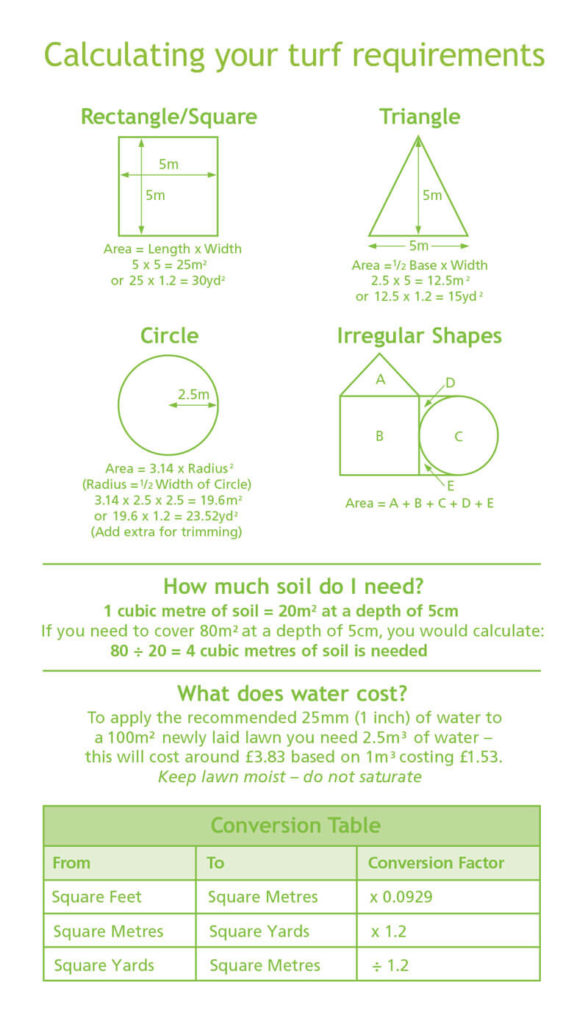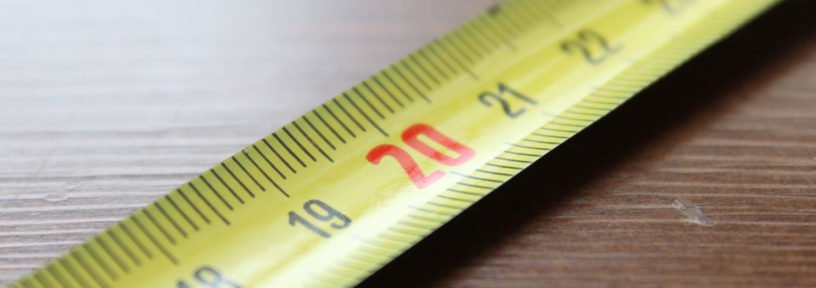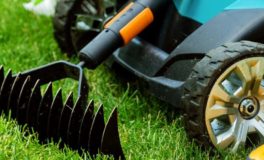First of all, congratulations if you have chosen to lay a new lawn from natural turfgrass. You’ve made a good choice. In this article we’re sharing some tips on how to measure your garden for new lawn turf.
- Prepare the soil first – so that you can be sure of your measurements
- Use a long tape measure – preferably one that reaches the whole length of the site
- Measure in metres and centimetres – this reduces the maths
- Measure each side twice
- Write measurements down as you take them
- Use a calculator and always double check your maths
- Add a little extra to allow for wastage
Preparing the area to measure
One of the most common (and expensive!) mistakes people make is that they guess where their new lawn might be and measure that area. Then, when it comes to laying the turf, they find themselves 3 or 4 rolls short. Finding 3 or 4 rolls to match and/ordering tiny amounts from the supplier is time consuming and expensive. So better to be sure of your layout before you measure your garden for turf.
The best way to do this is to prepare the area for turfing before you measure. Other advantages include
- You can start laying as soon as your new turf arrives, reducing the risk of sod heating
- If the rest of the garden is completed, there’ll be no need to walk on the turf before it is properly established.
Use a long tape measure
The secret to successfully measuring your garden for turf is to keep the maths to a minimum. When you use a long tape measure, you only need to take one reading. There’s no need to
add several measurements together.
Make sure you keep the tape taut and be sure to start the measurements at the very edge of where your new lawn will be. No creeping forwards!
A laser measure, if you have one, is a good alternative to a tape. Particularly if you don’t have a helper.
Use metric measurements
Converting your measurements from imperial to metric is another opportunity to make a mistake. As turf is sold by the square metre, it makes sense to measure in metres and centimetres.
Understanding the difference between “square metres” and “metres squared” might seem like splitting hairs to some, but for those dealing with measurements in fields like gardening, construction, real estate, or science, the discrepancy can have significant implications.
Let’s start with the basics:
“Square metres” (often abbreviated as sq. m or m²) is a unit of area measurement – the size of an area. Like a garden.
If your garden is 5m x 3m its area is 15 sqm.
To find the area of a space in square metres, one must multiply the length of the space by its width, resulting in a value expressed in square metres.
In this case, “square metres” represents the actual measurement of the area covered by the garden, similar to how one might quantify the size of a piece of land or the floor area of a building.
Metres Squared
On the other hand, “metres squared” (m²) is a mathematical expression involving the square of a unit of length. It is essentially a unit of measurement for a quantity derived from multiplying a length by itself, resulting in a value expressed in square meters.
The key distinction lies in the context and interpretation of the terms. “Square metres” quantifies actual area, while “metres squared” denotes the result of squaring a length, which represents area mathematically. They are not the same.
Understanding this subtle yet crucial difference can prevent misunderstandings and ensure accurate communication, especially in fields where precise measurements are essential. Whether you’re designing a building, assessing land area, or conducting scientific experiments, clarity regarding these terms is paramount for effective communication and accurate calculations.
Measure each side at least twice
I was once told by a brilliant carpenter “measure twice, cut once”. When you measure your garden for turf, you should measure twice and order once. It pays to double-check each measurement.
Oh – and don’t assume that an area is exactly rectangular. Measure each edge of your lawn.
For a circular lawn, measure straight across the middle at the widest part. Do that in at least 3 places for your own peace of mind.
For an irregularly shaped lawn, “square off” each edge in your imagination – you will need extra turf for trimming anyway.
Write each measurement down as you take it.
Don’t trust to memory when measuring for your new turf. Use a pen and pencil, a voice recorder or the notes facility on your smartphone to record every measurement as you take it.
Sometimes it helps to sketch a rough plan of the lawn and write the measurements against each side.
Calculating how much turf you need
Be sure to put the decimal point in the right place so that each measurement is in metres.
For example, if your lawn is 98cm x 124cm (tiny I know, but it’s only an example).
98cm = 0.98 metres.
124 cm, plug 1.24 metres into your calculator
Now multiply the length by the width
0.98 x 1.24 = 1.21 square metres = 2 rolls (1 roll = 1 square metre)
For circles or triangles, you’ll need to use a different calculation. This illustration will help.

Sound complicated?
Use our turf calculator instead
The Turfonline turf calculator can be used for square, rectangular or circular lawn areas.
Remember to check twice and if you’re not sure, get in touch with the Turfonline team who are always happy to help.
Add a little extra turf to allow for wastage
You will need to trim your turf to size and you may sometimes come across the odd rogue roll that doesn’t hold together brilliantly. The Turfonline team recommend adding an extra 5% to your order to avoid the situation we described in the first paragraph.
Don’t worry, if maths isn’t your thing, our online turf calculator is available 24/7 to help convert your measurements into turf rolls.

 Let’s build a garden – preparation
Let’s build a garden – preparation  How to Prepare Your Soil For Turfing
How to Prepare Your Soil For Turfing 

